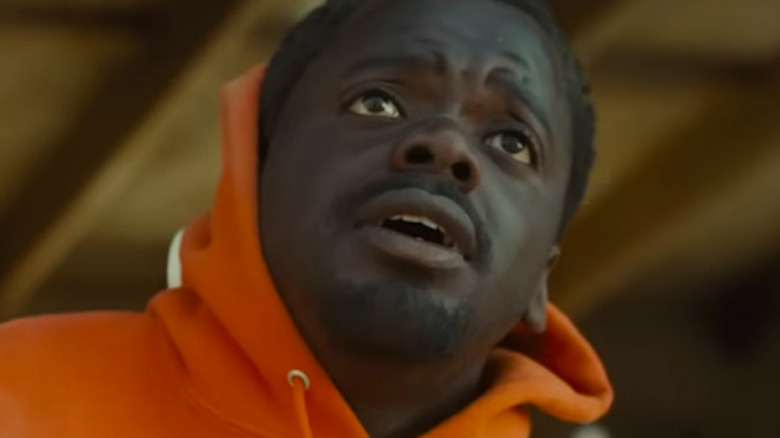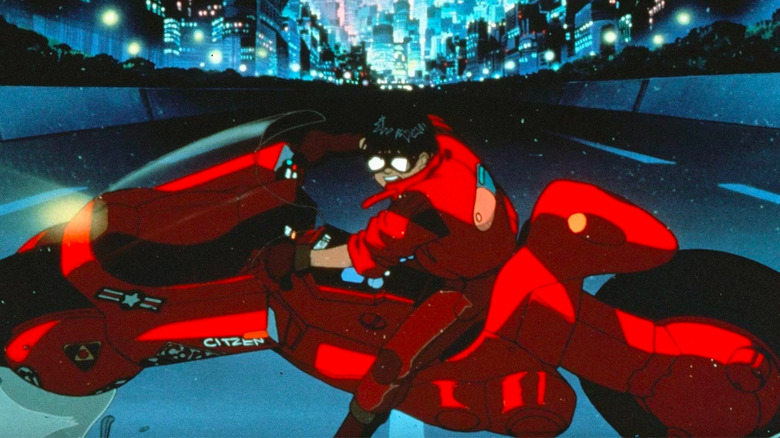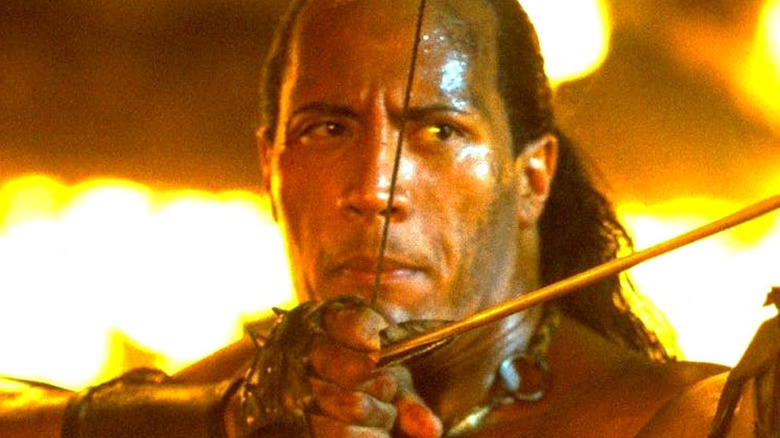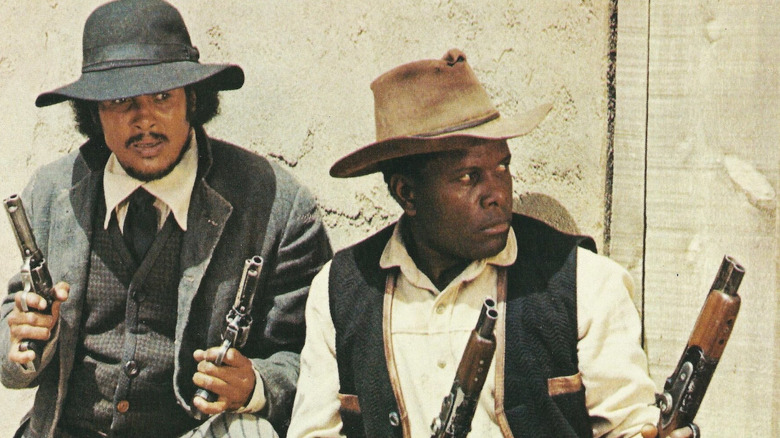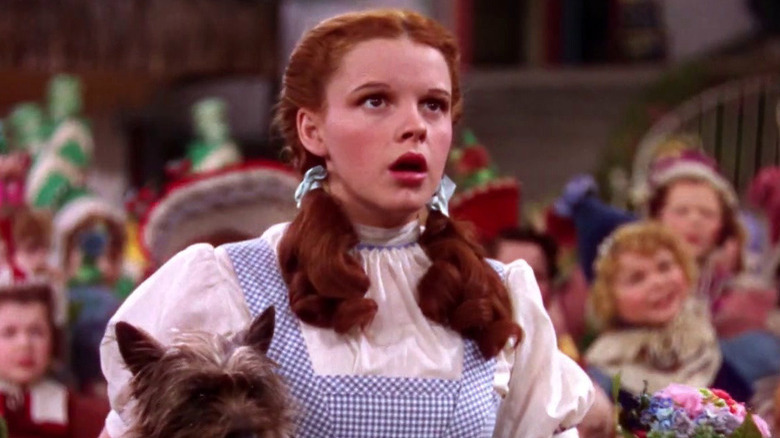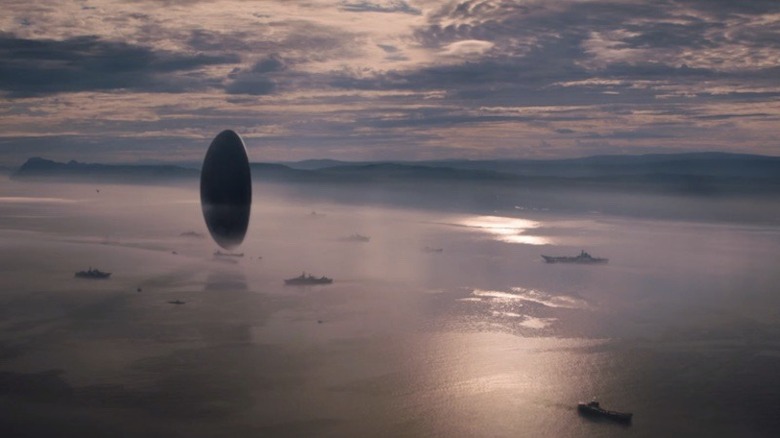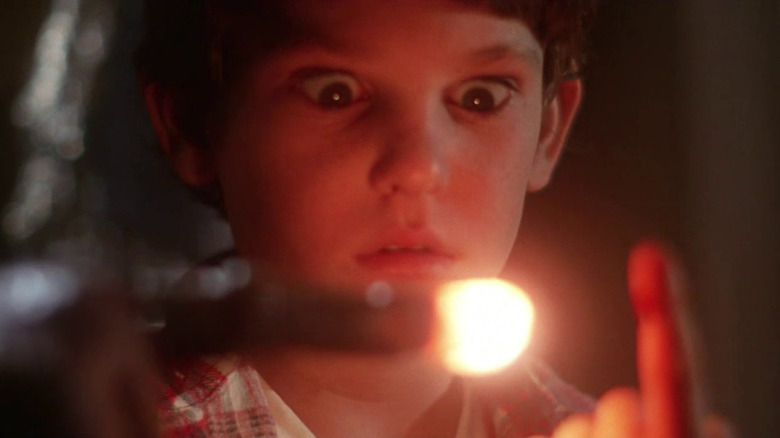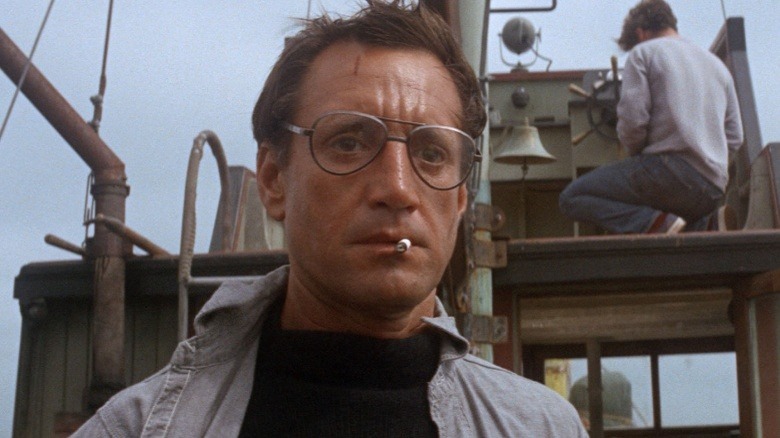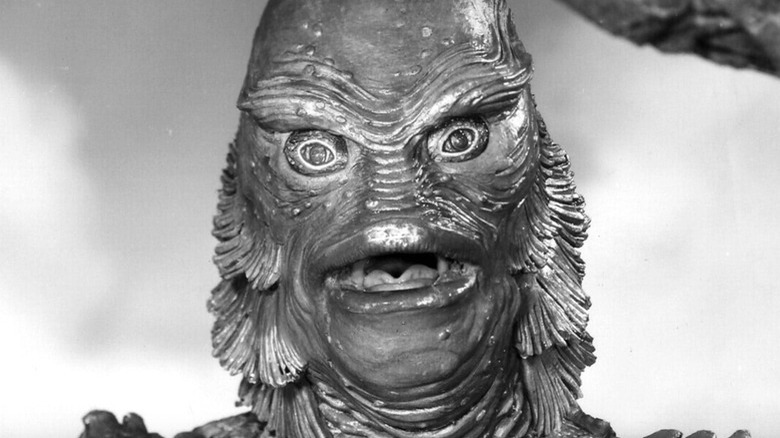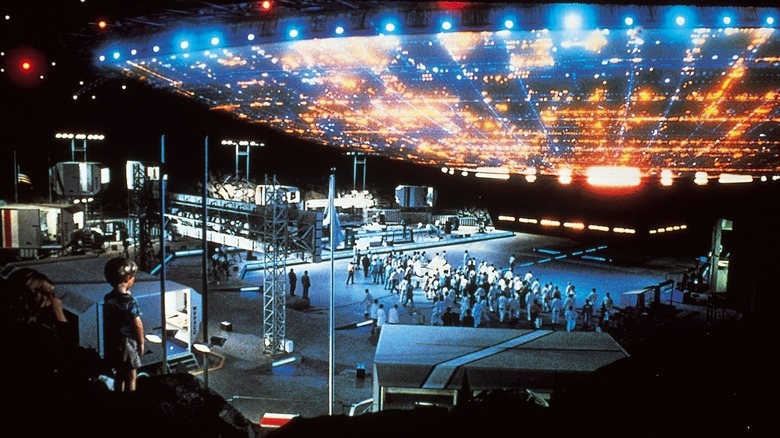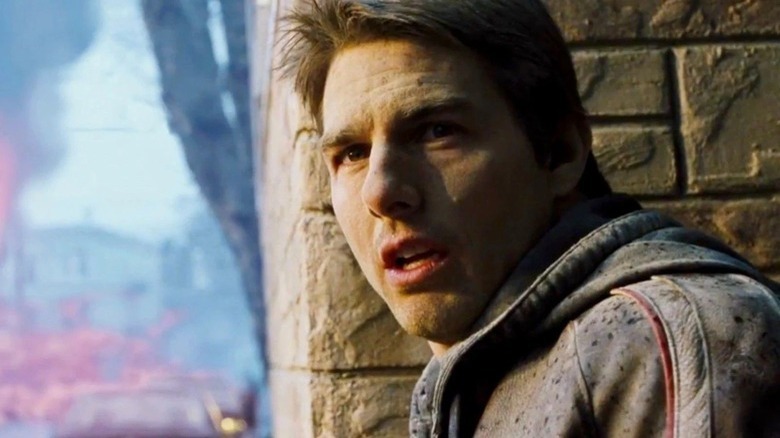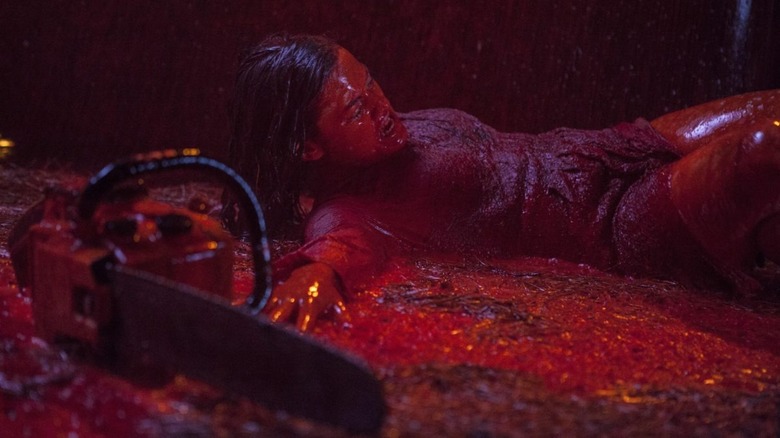Movie References That Totally Slipped By You In Nope
If we've learned anything about Jordan Peele as a filmmaker over the past few years, it's that everything he does is intentional, and his films are littered with Easter eggs and thematic and cinematic references. "Nope," his take on a UFO adventure movie, is no different. "Nope" follows two siblings, OJ (Daniel Kaluuya) and Emerald Haywood (Keke Palmer), who run a horse ranch in California following their father's mysterious death. They begin seeing and experiencing very strange things on the ranch, eventually coming to believe there's an extraterrestrial being hunting them. They enlist the help of an electronics specialist Angel (Brandon Perea) and experienced cinematographer Antlers Holst (Michael Wincott) to capture evidence of the creature. Meanwhile, their neighbor Ricky (Steven Yeun), a former child star, attempts to profit off the spectacle.
There are a number of central themes in "Nope," and one of them is the power of cinema itself. OJ and Emerald are the descendants of the jockey featured in Eadweard Muybridge's "The Horse in Motion," often considered the very first example of a motion picture. The family company, Haywood's Hollywood Horses, provides trained horses for film sets, continuing their ancestral connection to the film industry.
"Nope" also touches on the problems with our desire for spectacle and the need to always record everything, as well as the grinding, destructive force of capitalism. The film also illustrates the futility -– and, indeed, the dangers -– of trying to tame wild things. There's a lot to unpack in "Nope," so we thought we'd give you a leg up by examining all of the movie references sprinkled throughout the film. Naturally, there are spoilers ahead.
Akira (1988)
The most obvious movie reference in "Nope" is one of the most-referenced movie shots of all time. The movie in question is "Akira," the legendary 1988 anime film directed by Katsuhiro Otomo. The most famous shot in the film, called the "Kaneda Slide," is the moment where the lead character, a bike gang leader trying to save his friends from an evil government conspiracy, stops his motorcycle by abruptly turning and sliding it. There's even a popular YouTube video compiled by user Badspler that gives you a sense of just how many times the shot has been referenced in animated projects.
Despite the fact that it's an extremely common reference, Peele was adamant about including it in the film. Describing his thought process for including it, Peele told Cinema Blend, "Something about having a Black woman on a white motorcycle with, you know, having broken police tape do that 'Akira slide,' just felt like, 'You know what, Jordan? Go for it.'"
The famous shot comes near the end of the film when Emerald drives through Ricky's now-empty theme park to escape (and eventually trap) Jean Jacket. It's an incredibly badass scene, and it works perfectly as a climactic moment in the film. Keke Palmer's Emerald is such a confident and audacious character, so it's only fair that she gets her cool hero moment in the form of an anime reference.
The Scorpion King (2002)
This isn't so much an homage as it is an explicit reference within the film itself. OJ and Emerald's family business, Haywood's Hollywood Horses, provides trained horses for movies being shot in Hollywood. During one scene in the film, OJ tells Emerald about the first job his dad ever took him on as a young boy. The movie in question is 2002's "The Scorpion King," a spin-off of "The Mummy" series starring Dwayne Johnson as the titular character. Emerald recalls being jealous that OJ and her father went on the job without her and used the horse that had been promised to her, but OJ tells her it wasn't very fun anyway. Besides, the production never actually used the horses because they decided to use camels instead.
The actual movie wasn't all that fondly regarded, making it a pretty funny reference to make 20 years later. The most significant part isn't the film itself –- though it is an amusing choice for OJ's first job -– but the swag OJ got from working on the movie. After two decades, OJ has kept the bright orange "crew" sweatshirt despite his claims of how disappointing the experience was. In the pivotal climax of the film, OJ is seen wearing his "Scorpion King" sweatshirt, perhaps because of the memories it holds, or maybe because it will make him an easy target for the alien. It could be a little of both. The fact that the horse that was supposed to be Emerald's was named Jean Jacket –- the name OJ has also given the alien -– makes the connection to their character arcs even clearer.
Buck and the Preacher (1972)
While "Nope" references a lot of tropes from classic UFO and alien films, it also draws on the visual imagery of cowboys and Westerns. In particular, the film explores the iconography of Black cowboys, something often left out of American myth-making.
The legacy of Black cowboys is referenced explicitly within the Haywood house itself. There are a number of photographs and film posters on the wall, one of them being the poster for the 1972 film "Buck and the Preacher." The film was legendary actor Sidney Poitier's directorial debut, and it was made during the era of blaxploitation and the Black Power movement, which also led to a rise in Black-led Westerns being made during that decade.
Peele spoke with The Miami Times about his decision to reference this particular film. "It's the first film that I know of that had Black cowboys represented in it," he explained. "The myth that cowboys were just white guys running around, it's just not true, but we don't know that because of Hollywood and the romanticized view of a very brutalized era. The film, it shares a spirit."
Daniel Kaluuya's OJ certainly emerges as a heroic, cowboy-like figure by the end of the film, so Peele's Western reference works beautifully as foreshadowing. It's yet another example of how references like these can enrich your viewing experience if you're really paying attention.
The Wizard of Oz (1939)
This next reference may be fairly obvious in retrospect, but it's another witty homage to a classic of American cinema. 1939's "The Wizard of Oz" is one of the most famous American films of all time, and it's also one of the first films to be widely shown in Technicolor, making it very influential in more ways than one (per Vox).
Even if you haven't seen the film, you're probably aware of its most famous scenes. The central premise is that Dorothy Gale's (Judy Garland) Kansas house is picked up by a tornado and taken to a magical world called Oz. (In the film version, it's eventually revealed it was all a dream, while L. Frank Baum's original book contains no such reassurances).
The clearest reference to the film in "Nope" is one scene in which OJ is standing in front of the Haywood farmhouse, which looks much like the one Dorothy lived in. As OJ looks up at the sky, he watches a terrifying twister come toward him as storm clouds gather overhead. Of course, unlike in "The Wizard of Oz," the twister in question is not a meteorological phenomenon, but rather a hungry, terrifying creature from outer space. While the two films are quite different in tone, the reference makes it clear that Peele aims to situate "Nope" within a lineage of classic American storytelling.
Arrival (2016)
2016's "Arrival," starring Amy Adams and Jeremy Renner, is probably one of the greatest alien films of the 21st century. Denis Villeneuve's masterpiece is a totally new take on an alien invasion, imaging what might happen if we actually tried to peacefully communicate with extraterrestrials instead of immediately going on the defensive. In addition to the film's thematic elements, it's also influential in how it depicts the aforementioned aliens — there's the sleek, oblong shape of their spaceship, and the starfish-like legs of the brainy aliens themselves.
The influence of "Arrival" on "Nope" is most obvious in the construction of the alien creature in the film. While it initially appears as a smooth, saucer-like ship like the spacecrafts in "Arrival," OJ and Emerald soon realize it's not a ship at all, but a carnivorous creature. When the internal form of the creature is revealed, it recalls the squid-like aliens the humans encounter in "Arrival."
OJ's attempts to communicate with the creature also in some ways mirror the central struggle of "Arrival," though the stakes are pretty different. While the aliens in "Arrival" are found to be extremely intelligent and advanced, Jean Jacket seems to only care about satiating its appetite. Nonetheless, OJ invokes his substantial knowledge about animal training in order to communicate with Jean Jacket as if it were one of his horses, alluding to the same questions about how aliens might behave if they descended to earth.
E.T. (1982)
When you take a closer look at "Nope," it's clear that Steven Spielberg, the king of summer blockbusters, had a huge influence on the film. One of the most visually striking references in "Nope" is a very dark homage to one of Spielberg's most famous characters.
While "Nope" is ostensibly about an alien creature who feeds on humans, the opening of the film seems completely disconnected from the central storyline — at least at first. The first thing we see on screen is a flashback from the perspective of Ricky, former child actor and star of a popular sitcom called "Gordy's Home." The title character of the show is a chimp named Gordy, and what we're seeing is the aftermath of the animal star having gone berserk and violently attacked the entire cast. The only cast member not to be maimed or killed, Ricky he continues to exploit this traumatic event for money and fame into adulthood.
Later in the film, we return to Ricky's memory of the event, which is when the Spielberg reference comes in. After Gordy has just attacked everyone on set, he reaches a bloody fist out to Ricky, trying to recreate their characters' famous fist-bump. Their two hands slowly come together, until Gordy is suddenly shot. This rather terrifying moment mirrors the (much more wholesome) scene in "E.T." when Elliot (Henry Thomas) touches fingers with his alien friend. As in "E.T.," where all of the adults around Elliot see the alien as a threat while he sees him as a friend, Ricky still feels he has a connection to Gordy despite the rampage.
Jaws (1975)
One of the most famous creature movies of all time, Steven Spielberg's 1975 film "Jaws" had a clear influence on Jordan Peele's take on a monster movie. "Jaws" was incredibly successful when it was first released and was one of the first summer blockbusters of its kind, so it's no wonder Peele referenced this film in his own (deceptively complex) summer blockbuster.
The clearest connection between "Nope" and "Jaws" can be found in the third act of both films. While the first two acts of "Jaws" follow beachgoers as they're terrorized by a bloodthirsty shark, the final act of the film follows three men –- Police Chief Brody (Roy Scheider), oceanographer Hooper (Richard Dreyfuss), and grizzled shark hunter Quint (Robert Shaw) –- as they make a plan to hunt down and kill the animal.
"Nope" assembles its own scrappy team of monster hunters as tech expert Angel joins OJ and Emerald in their quest. The reference becomes even more explicit with the addition of cynical, obsessive cinematographer Antlers Holst, who is very clearly the Quint of the group. (Like Antlers, Quint also dies while going mano-a-mano with the creature.) One thing that makes "Jaws" so effective is its now-famous plot structure, which is utilized in a similarly powerful way in "Nope." Nonetheless, despite all these classic cinematic references, "Nope" still emerges with its own point of view and plenty to say about American culture as a whole.
Creature from the Black Lagoon (1954)
Spielberg's "Jaws" drew a lot from the horror classic "Creature from the Black Lagoon," so it's no surprise "Nope" would do the same. This 1954 Universal Monster outing remains an extremely influential film, and it also marks a huge development in the field of underwater photography. Another notable element is the film's emphasis on the audience being able to empathize with the creature, who is more like an animal than it is a monster. The film follows a group of scientists who travel to South America to find evidence of a mysterious and potentially dangerous animal. They eventually find what they're looking for, but their efforts to trap, catch, or otherwise tame the creature backfire.
Unlike Ricky, who tries to toy with the alien at the center of "Nope" for his own gain — or even Antlers, who wants to capture it on film no matter the cost — OJ understands that Jean Jacket is an animal like any other. Rather than seeing Jean Jacket as a purely malevolent force, OJ realizes that the creature is simply following its base instincts, namely hunger.
One of the most striking characteristics of "Creature from the Black Lagoon" is its use of first-person perspective from the viewpoint of the creature. While we don't exactly get this in "Nope," we do get a ton of really fascinating (and thought-provoking) shots of what is presumably the interior of the creature. While this doesn't necessarily cause us to empathize with Jean Jacket, this literal interiority does give us a better understanding of its innate, animalistic impulses.
Close Encounters of the Third Kind (1977)
Steven Spielberg, arguably the master of the blockbuster film, has made a few movies about extraterrestrials, so it's no wonder he was such a big influence on "Nope." Following the success of "Jaws," Spielberg's fourth feature was 1977's "Close Encounters of the Third Kind," a classic in the alien genre. The film stars Richard Dreyfuss as Roy Neary, a man who has an encounter with an alien spaceship and is determined to prove what he saw was real, no matter the cost.
There are a number of similarities between "Close Encounters of the Third Kind" and "Nope." First, there's the appearance of a flying saucer (or what looks like a flying saucer) setting off the events in both films. Both UFOs seem to precipitate stormy weather and electrical outages as well. But the similarities don't stop there — one of the most striking characteristics of the creature in "Nope" is that it camouflages itself in the clouds. The UFO in "Close Encounters" behaves similarly, abducting a young boy and then seemingly disappearing into the clouds above. Lastly, both OJ and Roy have terrifying encounters with their respective extraterrestrials while sitting in their trucks, as the UFOs in both films fly directly over the two men.
The character arcs in both films are similar as well. Roy is obsessed with proving the existence of UFOs -– to his own detriment -– while the Hawyoods are similarly committed to finding evidence of what they've seen, though for different reasons. What Peele emphasizes in the film is how dangerous this obsession with documenting everything really is.
War of the Worlds (2005)
The alien creature in "Nope" seems to have a strong influence on the weather, which is why the characters in the film are able to see (and feel) it coming. There's another film in Spielberg's repertoire that makes a similar connection between an alien invasion and the weather: 2005's "War of the Worlds," which stars Tom Cruise as everyman Ray Ferrier. Based on the H.G. Wells novel of the same name, the film depicts an immense alien invasion on earth using war machines known as "tripods." As in "Nope," the invasion starts with a strange storm wherein lighting fries all the electronics in the area.
One of the most striking moments of the film is mirrored in "Nope." After hiding in the basement with his children, Ray emerges to find that the sky is black and the air is misted with blood from all the humans the aliens have just devoured. This scene is echoed in one of the most awe-inspiring moments in "Nope" when Jean Jacket, full after eating all of those people at Ricky's theme park, releases a boatload of blood (among other things) right on top of the Haywood house. It's a magnificently executed storm of blood, and the aftermath -– in which the entire house is stained red — parallels that first alien scene in "War of the Worlds," albeit on a smaller scale.
The Shining (1980), Blade (1998), and Evil Dead (2013)
The scene where blood rains down on the Haywood house is one of the most jaw-dropping scenes in the entire movie, so we wouldn't be surprised if Peele had multiple cinematic reference points for it. One of the most famous blood-soaked scenes in film history occurs in Stanley Kubrick's 1980 film "The Shining." While Wendy (Shelley Duvall) hides from her unhinged husband, she encounters a gushing river of blood cascading from the elevators.
It's not really raining blood in that scene, though, so we might want to hunt for a few more examples. There's also 1998's "Blade," which has one extremely memorable bloody scene. The opening sequence of the film takes place at a vampire nightclub where blood rains down on its patrons from the ceilings. We should also consider the 2013 remake of "Evil Dead," which cleverly uses an incidence of bloody rain in its gory climax.
There are certainly a number of bloody horror sequences Peele could have drawn from, but these are three of the most memorable and the most visually striking. The raining blood scene in "Nope" will definitely go down in history as another entry in this category, following in the crimson footprints of those that have come before it.
